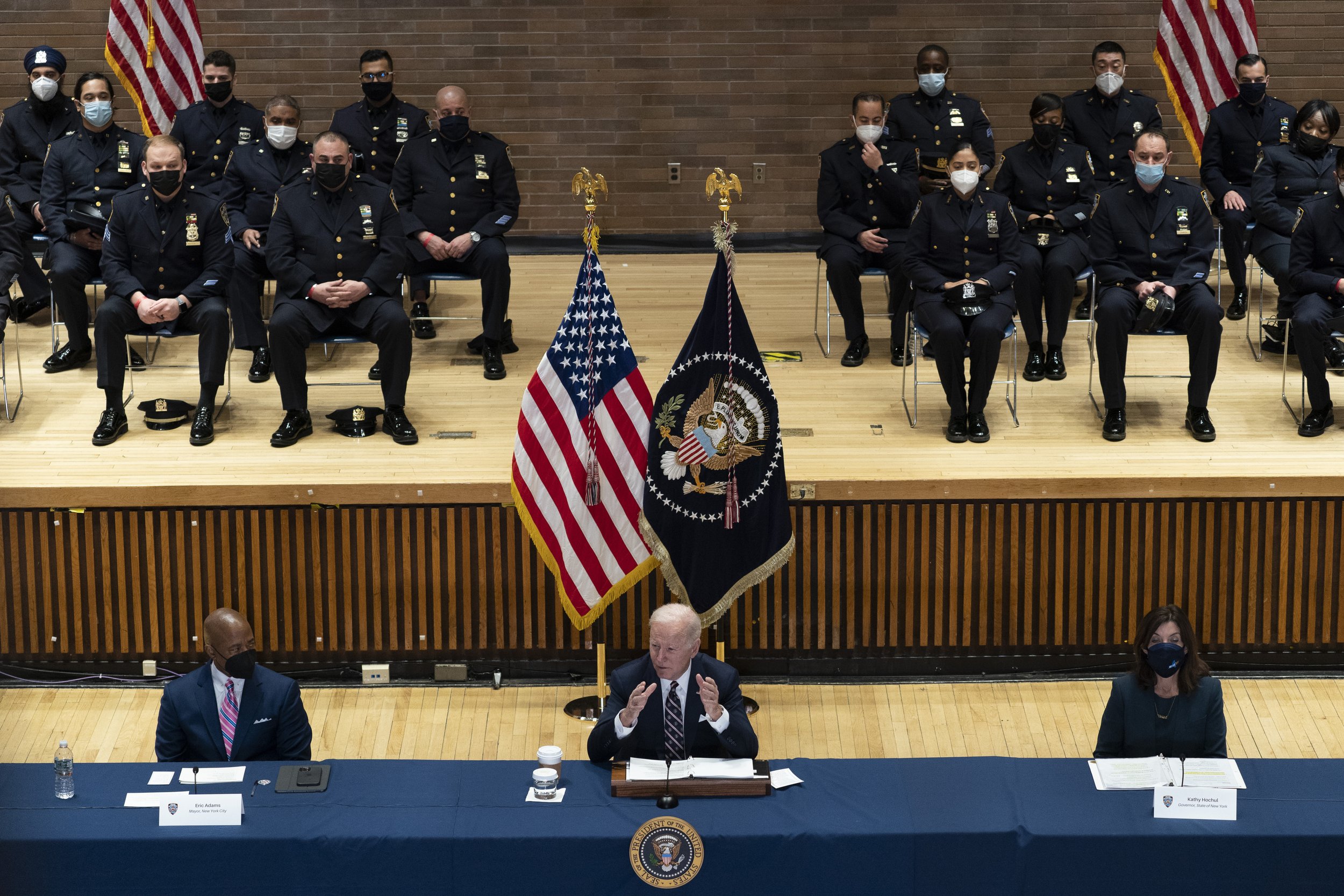Biden visits Queens, meets with leaders to address gun violence
/President Joe Biden met with a number of New York officials, including Mayor Eric Adams and Governor Kathy Hochul, at One Police Plaza to discuss the country’s gun violence prevention strategy on Thursday, Feb. 3, 2022. AP Photo/Alex Brandon
By Jacob Kaye
A wide range of local, state and federal officials, including President Joe Biden, gathered Thursday at NYPD headquarters in Manhattan and, later, in Queens, to discuss a unified response to the recent uptick in gun violence in New York City.
Biden met with Governor Kathy Hochul, Mayor Eric Adams, the majority of New York’s congressional delegation, NYPD Chief Keechant Sewell and others to talk about combined efforts made at all levels of government to address gun violence in New York City, which recently left two young NYPD officers dead.
“The answer is not to abandon our streets – that's not the answer,” Biden said at One Police Plaza. “The answer is to come together, police and communities, building trust and making us all safer.”
“The answer is not to defund the police, it’s to give you the tools, the training, the funding to be partners and to be protectors to a community that needs you,” he added.
New York City has seen a nearly 35 percent increase in shooting incidents in the past year, according to NYPD statistics. Though murders throghout the five boroughs have decreased in the past year by nearly 20 percent, several high profile shooting deaths have brought renewed attention to gun violence.
Biden’s visit came a day after the funeral of NYPD officer Wilbert Mora, the second of two officers to be killed during a domestic violence call on Jan. 21. It also came two days after the shooting of an off-duty officer in Queens who was released from the Jamaica Hospital Thursday afternoon – Sewell and other NYPD officials left the meeting with Biden early to see the officer out of the hospital.
On Thursday, the White House rolled out its plan to address gun violence throughout the country. In the absence of legislation from Congress, the plan relies heavily on participation from state and local governments, something the president acknowledged.
“Enough is enough, because we know we can do things about this,” Biden said. “But for the resistance we're getting from some sectors of the government and the Congress and the state legislatures and organizational structures out there.”
Around 315 people are shot and 106 are killed every day in the U.S., according to Biden. This year alone, 26 children have died from gun violence.
While the plan, in part, focuses on community prevention strategies, it focuses mostly on law enforcement tactics to arrest and prosecute gun dealers.
Building on a gun violence plan introduced last summer, Biden said there were three major additions to the federal government’s response to the spate of shootings.
The president said the federal government will do more to crack down on the Iron Pipeline – the route gun traffickers use to ship guns from the south up along the East Coast – by adding personnel to strengthen the Justice Department’s task forces dedicated to the flow of guns across state lines.
He also said the White House plans to launch the National Ghost Gun Enforcement Initiative, a program that aims to train prosecutors throughout the country and provide prosecution tools to help bring cases against people who use ghost guns.
Additionally, Biden’s plan includes prioritizing federal gun trafficker cases, including cases that involve unlicensed dealers or dealers who criminally sell guns that are later used in violent crimes.
The president said that the White House would also be directing every U.S. attorney’s office to increase its resources dedicated to violent crime strategies in their districts. Included in those strategies is the city’s Gun Violence Strategic Partnership, which relies on community violence interrupters and community policing.
Following the meeting at police headquarters, the president traveled to Long Island City’s P.S. 111 to meet with Dionne Jaggon, the school’s principal and K. Bain, the founder of 696 Build Queens Bridge, Community Capacity Development and one of the creators of the Crisis Management System, a city program that employs credible messengers to serve as violence interrupters in neighborhoods with relatively high rates of violence.
Bain’s violence interruption program is one of the most successful in the city, according to city officials. In 2016, Queensbridge, the largest public housing complex in the United States, didn’t see a single murder. It was also the first full year of work for Bain’s program.
Bain partnered with P.S. 111 and has been working with the school’s students for the past several years, he told Biden Thursday.
“[This is what happens] when you get leadership in a school that immediately buys into this human justice approach to dealing with conflict,” Bain said.
Adams, who said the response to gun violence in New York City should be comparable to the response to the Sept 11 attacks, said that he asked Biden to meet with the violence interrupters during a recent trip to the White House.
“It's about intervention and prevention, and prevention are the long term things we need to do,” Adams said. “I asked him to go on the ground with us to meet the crisis management teams, the everyday people who are doing the hard work in alignment with the police department.”
Queens Borough President Donovan Richards celebrated Biden’s approach to attacking gun violence Thursday.
“As he demonstrated today in his visit to the World’s Borough, President Biden wholly believes in striking that necessary balance between firmly cracking down on those who traffic often untraceable guns into our city via the Iron Pipeline and addressing the root causes of violence in our city, while empowering our networks of community violence interrupters who save lives every day,” Richards said. “I am deeply grateful to the President for not only his presence here in Queens today, but his pledge of close partnership.”




